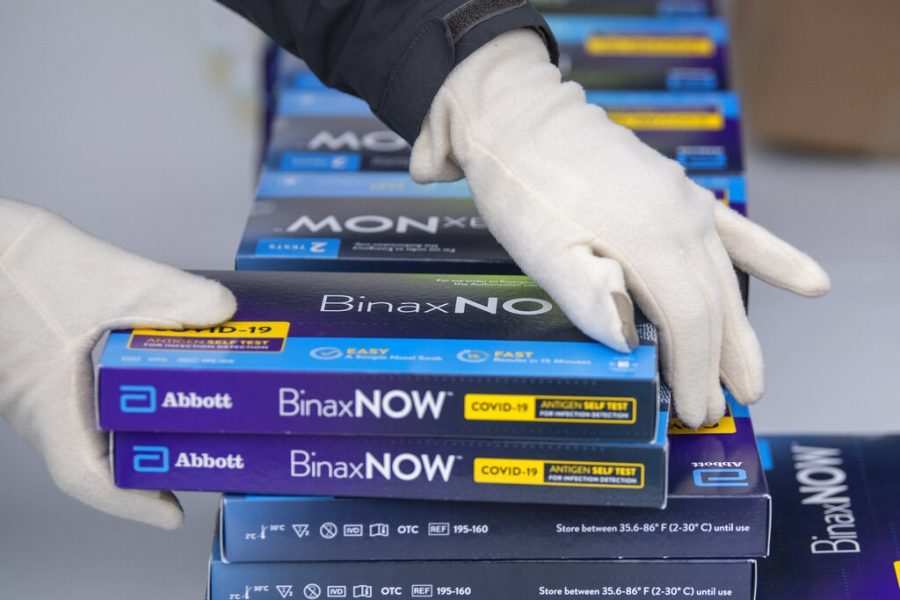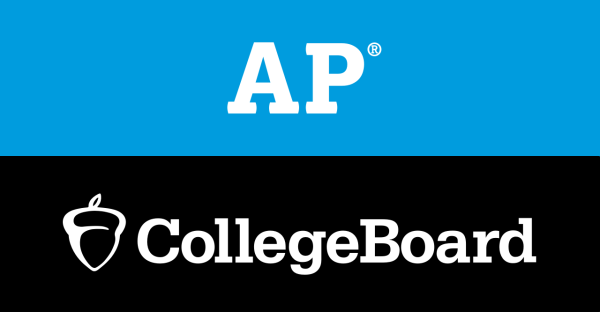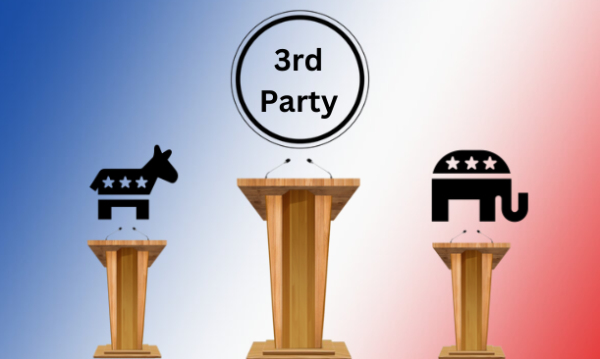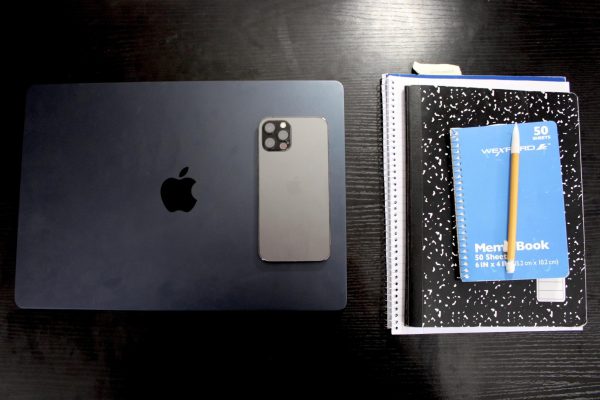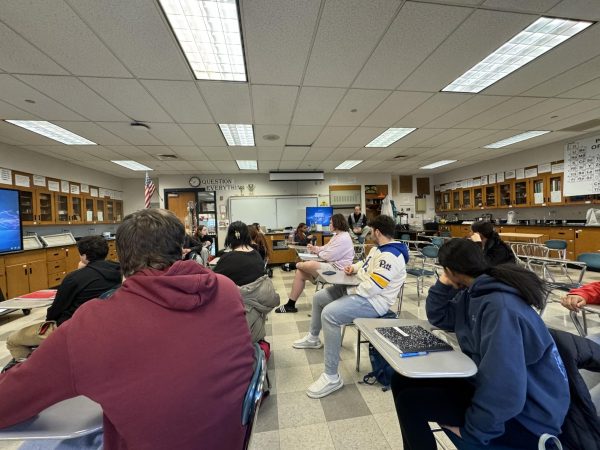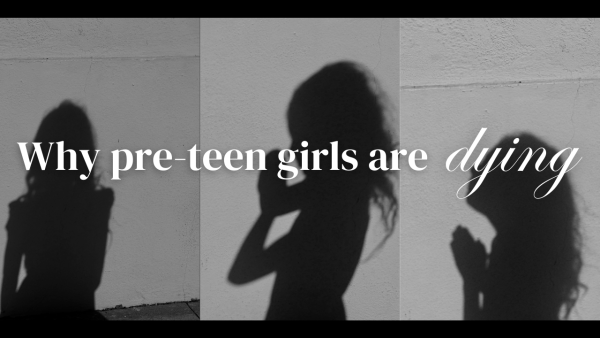Opinion: Covid response amplifies dollars over disease
FILE – Youngstown City Health Department worker Faith Terreri grabs two at-home COVID-19 test kits to be handed out during a distribution event, Dec. 30, 2021, in Youngstown, Ohio. Starting Saturday, private health insurers will be required to cover up to eight home COVID-19 tests per month for those on their plans, the Biden administration announced Monday, as it looks to lower costs and make testing for the virus more convenient amid rising frustrations. (AP Photo/David Dermer, File)
Opinions expressed in the Op/Ed section of The Knight Crier are not necessarily reflective of the views of the entire staff of the KC.
There I was on Christmas Day, staring at my parents’ positive rapid antigen test results, apprehensively awaiting the inevitable positive blue bar on my pending test to reveal its face of calamity. The pandemic has carried on for almost two years, and not one member of my family has caught the virus due to the precautions that we took. Not once before in my lifetime have I left my household on Christmas day, only for that tradition to change for desperate attempts to acquire sparsely stocked Covid-19 tests for my family and I, finally obtaining a few, hours later in view of newfound one-per-person test purchasing policies, stemming from the oft mentioned supply chain shortages.
Advancing to the two year milestone of the Covid-19 pandemic, it’s no understatement to affirm this virus has never taken a pause in the continuation of its rampant path. Spreading like wildfire for a biennium, this ailment has triggered one of the sharpest and deepest economic contractions in the history of industrialized society. Collapsing long supply chains, declining rates of trade and international travel, Covid-19 has essentially strived to ‘de-globalize’ the connected modern world. Within weeks of its initial influx, millions of workers joined the unemployment pool and millions of businesses were facing the most challenging times since their existence. With this pattern finding little breaking points for over a year later, and with these complexities transmuting into newfound issues deriving from previously unsolved complications in the face of emerging strains, the average working citizen still commonly faces the short end.
Omicron, this infamous mutation plaguing the developed world, and devastating developing nations, is only the mere result of when proper mitigation efforts aren’t imposed to eliminate contagions. When epidemiological approaches aren’t implemented in Covid-19 response, and particularly substituted with applications pertaining to pecuniary interests, strain after strain will continue to dominate the daily lives of people for even further prolonged periods of time.
When epidemiological approaches aren’t implemented in Covid-19 response, and particularly substituted with applications pertaining to pecuniary interests, strain after strain will continue to dominate the daily lives of people for even further prolonged periods of time
The symptoms I experienced were mild, but testing was imperative for them per CDC guidance. These rapid antigen tests in question that come into communities stockpiled only to dissipate in the matter of a day range from $10.00 to $25.00 dollars a test. In an average family of four, two parents that have symptoms would need to be periodically tested if their symptoms continued in order to return to their places of work, and their two children would also need to be periodically tested in order to return to school. For just two tests for each family member, as needed per the CDC’s most recent guidance, will cost anywhere from $80.00 up to $200.00 in the matter of a week. In a district like North Penn, where almost 20% of students are economically disadvantaged, that cost can take a toll, even among households with income that doesn’t fall beneath the poverty line.
In a society where this testing has become so obligatory from surfacing variants, there is no plausible way to extraordinarily price gouge an object proving to be so necessary, and simultaneously distinguish which scenario should prioritize a test, a common factor in these newly proposed testing patterns and policies. These sites cannot meet a community’s testing needs, especially in the face of a surge like Omicron that has reached to such an unprecedented extent, leaving them vulnerable to retailers like Tanga, selling single boxes of BinaxNOW tests for prices that reach $59.99, exploiting their despair among empty shelves.
Intensification of these disparities and income inequalities are reinforced through policy responses that have done little to protect the most vulnerable from the health and socio-economic impacts of COVID-19. The most recent, yet far too delayed, Biden administration action to supply free testing to those in need, however limiting the amount of tests applicable to each person, and taking as long as two weeks to deliver those tests with care, is an exemplary factor. How can an impoverished family, specifically which this motion strives to aid, that wishes to return to their occupational establishment or educational setting receive a test in a timely manner without breaking their savings just to simply test themselves? This pandemic, and these real world situations have revealed the materiality of human activity and complex geographies of inequality. It has enlightened us how inequalities embedded in relations of production, reproduction, and global finance continue to perpetuate this predisposed divide.
This pandemic, and these real world situations have revealed the materiality of human activity and complex geographies of inequality. It has enlightened us how inequalities embedded in relations of production, reproduction, and global finance continue to perpetuate this predisposed divide.
The aforementioned symptoms that were experienced during my time in isolation were mild, however the standards of the term “mild” prove to be redundant and misleading in this ongoing scenario when the outcome can be met with hospitalization and death. Even “mild” cases can result in long COVID, which includes a range of conditions like cognitive impairment, POTS, and chronic fatigue.
As this newly revised CDC guidance breaking through days into my quarantine, with such guidelines revolving around the institution’s abstract interpretations surrounding the term ‘mild,’ it came to a surprise that a virus that previously plagued the world was able to be mitigated in a matter of these recently appointed five-day isolation guidelines. The initial call for these newfound Covid-19 isolation regulations come from Delta CEO Ed Bastian, in his initial letter of request to the Center for Disease Control and Prevention, urging the institution to reconsider its stance on breakthrough infections. Fitting for this pandemic, now to be seemingly thought of and treated henceforth as an epidemic, as soon as mega corporations that previously profited off the exploitation of wage labor by keeping their companies afloat, have finally started to put their foot down.
The idea of urging people to work and return to occupational and educational institutions just five days after their influx of symptoms is sociopathic and unquestionably informed by a culture that accepts sacrificing human lives for profit margins as a fair and free trade. If an extra five days of absence in an occupational setting is such a tribulation, then how can we, as Americans, comfortably label America as a global economic superpower? The science surrounding Covid-19 undoubtedly evolves, but band-aid solutions to patch centuries-long capitalistic complications evolve quicker.
Facing these issues with an economic and financially centered ethos, even through continuous impediments, only steepens monetary disparities between economic classes. As we continue to navigate our way through the final stages of this pandemic, it’s crucial we, as a country, put health and well-being before interests revolving around the dollar, especially when the result is a greater financial divide disconnecting Americans.


